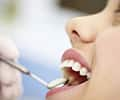Anatomy
The name “articular eminence”; may sound strange at first, but as you learn more about its function, you'll understand why it's an appropriate name. The word “articular” means that this structure is part of a movable joint. The term “eminence,” when concerning anatomy, means an elevation or projection. Overall, it's a raised area on the temporal bone of your skull.
As explained by a study in The Scientific World Journal, the AE is a part of the temporal bone, a fused portion of the skull surrounding each of your ears. The AE is located in front of the lower half of your ears. It's positioned directly in front of the hinge portion of your lower jaw, protruding downward from the central part of the temporal bone in a semicircle shape.
Role of the Articular Eminence in Jaw Movement
According to a study in the Journal of Dental Sciences, the TMJ is one of the most complex joints in the human body because it has the unique ability to move on all three planes of motion, which include up and down, side to side, and back and forth. Think about how you can move your jaw in a circular motion. That's unique! The AE guides the path of the top end of your jawbone, known as the condyle, as well as the degree of its rotation. Then there is the articular tubercle, where some ligaments laterally attach to the TMJ, and the condyle moves over it when the jaw opens.
Simply put, this means that the AE controls how far your jaw (or mandible) can open. When the mandible lowers to open, the AE restricts its ability to move and controls how far it rotates. In between the AE and the topmost portion of the mandible is a structure called the articular disk that cushions the movement.
TMJ Disorders and Treatment
If you're concerned that you may be having problems with your jaw, it's best to visit your dental or medical professional sooner rather than later. While we recommend seeking timely professional care, there's no need to panic. To experience pain or discomfort in your jaw is quite common, and there are various causes. It can also manifest in several types of symptoms. You may have a TMJ disorder if you experience a clicking or popping sound as you open or close your jaw, tightness in the jaw muscle that results in a limited ability to open your jaw, or any widespread pain or tenderness in the joint. Did you know that the AE's shape and angle can vary among people and make some individuals more likely to experience TMJ problems? Grinding or clenching habits cause strain to the TMJ and can intensify any existing issues, especially if you grind your teeth while you sleep.
TMJ discomfort or pain will sometimes go away on its own, but some individuals experience persistent issues and symptoms that need treatment. Recommended treatments can include over-the-counter pain relievers, anti-inflammatory medications, or even muscle relaxers. Your dental professional might also recommend wearing a mouthguard while you sleep. Ice and heat applied to the area can also be a natural way to relieve pain at the TMJ soreness site. As a last resort, your dental or medical professional may recommend surgery. But there are so many other treatment types to try; we recommend exploring all your other options first!
Ultimately, your dental professional's understanding of your particular jaw anatomy, symptoms, and issues will help them make the most informed and effective treatment recommendations for your TMJ disorder. When considering why you may have pain in your TMJ, your articular eminence is an essential part of your mouth's structure to consider. It plays a critical role in your jaw's function, so it is helpful to understand it better. Hopefully, you're on your way to a deeper understanding of and less pain in your TMJ with this knowledge!
Oral Care Center articles are reviewed by an oral health medical professional. This information is for educational purposes only. This content is not intended to be a substitute for professional medical advice, diagnosis or treatment. Always seek the advice of your dentist, physician or other qualified healthcare provider.
ORAL HEALTH QUIZ
What's behind your smile?
Take our Oral Health assessment to get the most from your oral care routine
ORAL HEALTH QUIZ
What's behind your smile?
Take our Oral Health assessment to get the most from your oral care routine
Join Us
Get the best of your oral health routine and take it to the next level with expert advice, recommendations, products and solutions and special offers.
Join Us
Get the best of your oral health routine and take it to the next level with expert advice, recommendations, products and solutions and special offers.















